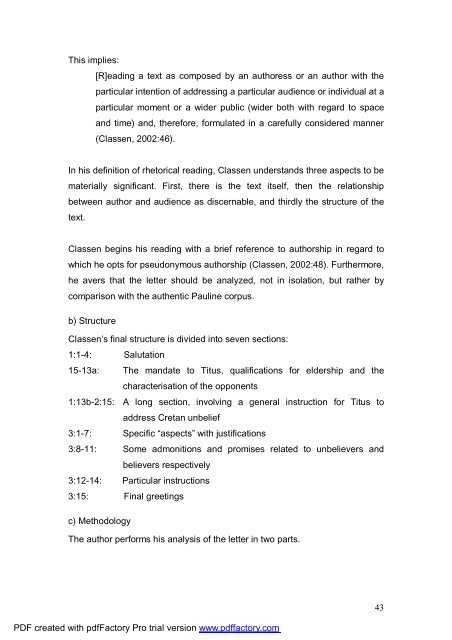A Text centred rhetorical analysis of Paul's Letter to Titus
A Text centred rhetorical analysis of Paul's Letter to Titus
A Text centred rhetorical analysis of Paul's Letter to Titus
You also want an ePaper? Increase the reach of your titles
YUMPU automatically turns print PDFs into web optimized ePapers that Google loves.
This implies:<br />
[R]eading a text as composed by an authoress or an author with the<br />
particular intention <strong>of</strong> addressing a particular audience or individual at a<br />
particular moment or a wider public (wider both with regard <strong>to</strong> space<br />
and time) and, therefore, formulated in a carefully considered manner<br />
(Classen, 2002:46).<br />
In his definition <strong>of</strong> <strong>rhe<strong>to</strong>rical</strong> reading, Classen understands three aspects <strong>to</strong> be<br />
materially significant. First, there is the text itself, then the relationship<br />
between author and audience as discernable, and thirdly the structure <strong>of</strong> the<br />
text.<br />
Classen begins his reading with a brief reference <strong>to</strong> authorship in regard <strong>to</strong><br />
which he opts for pseudonymous authorship (Classen, 2002:48). Furthermore,<br />
he avers that the letter should be analyzed, not in isolation, but rather by<br />
comparison with the authentic Pauline corpus.<br />
b) Structure<br />
Classen’s final structure is divided in<strong>to</strong> seven sections:<br />
1:1-4: Salutation<br />
15-13a: The mandate <strong>to</strong> <strong>Titus</strong>, qualifications for eldership and the<br />
characterisation <strong>of</strong> the opponents<br />
1:13b-2:15: A long section, involving a general instruction for <strong>Titus</strong> <strong>to</strong><br />
address Cretan unbelief<br />
3:1-7: Specific “aspects” with justifications<br />
3:8-11: Some admonitions and promises related <strong>to</strong> unbelievers and<br />
believers respectively<br />
3:12-14: Particular instructions<br />
3:15: Final greetings<br />
c) Methodology<br />
The author performs his <strong>analysis</strong> <strong>of</strong> the letter in two parts.<br />
PDF created with pdfFac<strong>to</strong>ry Pro trial version www.pdffac<strong>to</strong>ry.com<br />
43

















